The Often Forgotten Ingredient For Measuring Content Marketing
Tags:
 Content marketing is now a way of life for B2B businesses. It’s one of the primary ways B2B marketers generate and nurture leads, establish thought leadership, build their brands, expand their social following, and engage with and retain customers.
Content marketing is now a way of life for B2B businesses. It’s one of the primary ways B2B marketers generate and nurture leads, establish thought leadership, build their brands, expand their social following, and engage with and retain customers.
If you’re a B2B marketer, this probably isn’t news. We’ve been reading and hearing about the importance of content marketing for years. But it was still good to see the importance of content marketing confirmed in a recent 2013 study by the Content Marketing Institute, which found that 33% of B2B marketing budgets are now allocated to content marketing, which is up from 26% in 2011.
Content marketing has certainly arrived. But with increased budget comes increased scrutiny from executives and higher-ups. And getting management to buy in to the importance of content marketing – and the necessity of increasing their investment in it – can be a challenge. It’s now no longer good enough to create engaging content, you have to be able to prove its ROI, and that requires the right data and tools.
Proving content marketing needs data
Good marketing teams are able to show how their content is having a positive impact on the following.
- Web traffic
- SEO
- Social media followers
- Newsletter email lists
- Blog subscribers
- Email open and click-through rates
- Video views
Measuring that data is a good start, but while those numbers are useful in understanding the types of content and topics your audience enjoys, they aren’t going to impress most executives.
Better marketing teams can show how their content is having a direct impact on lead generation. Being able to demonstrate that this eBook or webinar generated X amount of leads usually gets an exec’s attention, but this usually isn’t enough to convince them that your content marketing budget is worth increasing (or, in some cases, justifiable as it already is).
Show me the money
That’s why the best marketing teams are the ones that can prove how those leads from content marketing are impacting revenue. For CEOs, revenue is everything.
They need to see the money.
It’s the key figure that will get them not only to buy in to the value of content marketing, but also to approve an increase in your budget.
Three essential analytics tools
Being able to prove how content marketing is impacting revenue requires three analytics tools. The first two are a marketing automation tool and a CRM system.
1. Marketing automation
Marketing automation tools like Marketo, Eloqua, or Pardot enable you to capture leads from web forms and to tie those leads to the marketing source that referred them. This means that you can create reports on how many leads each of your eBooks, white papers, webinars, and other content generated, as well as the email, web page, social media post, blog, video, PPC ad, SEO term, or other source the lead used to find you.
2. CRM systems
What’s more, when you integrate your marketing automation tools with a CRM system like Salesforce.com or SugarCRM, you can track each of those web leads through the sales cycle. And that means being able to prove to execs that your content marketing has generated X amount of web leads, Y amount of opportunities, and Z amount of revenue.
So what tool is often missing?
The often forgotten analytics tool
The data available from a marketing automation tool integrated with a CRM system can be very powerful, but if that’s all you are using to defend your content marketing, you aren’t doing it justice.
That’s because all you are measuring are the opportunities and revenue from web leads. You aren’t capturing the inbound phone calls your content is also generating, and this is problematic for two big reasons:
- You might not be getting credit for a ton of content marketing leads. If someone reads a blog and calls sales, for example, or calls after watching a video, reading collateral from a trade show, or getting a nurturing email, you can’t prove it.
- Inbound phone calls are often from leads who are ready to engage with a sales manager, and therefore more likely to become revenue than a web lead. Phone calls are the leads you most need to track back to your content.
That’s why the third analytics tool every B2B marketing team should use is a call tracking tool. Call tracking tools enable you to include unique trackable phone numbers in your downloadable and printed content, videos, trade show presentations, emails, ads, and direct mail blasts to measure the calls they generate. Even if a lead visits your web site before calling you, call tracking tools can still tell you how that caller found your site and the web page or blog posts they called from.
Integration is key
And like marketing automation tools, you can integrate call tracking tools with your CRM system to follow each phone lead through to revenue. By using all three analytics tools together, you can share detailed, accurate reports on the impact your content is having on the business’s bottom line. It’s an extremely compelling defense of content marketing that CEOs can understand. Plus you have the more granular data marketing teams can use to understand what content is working and what isn’t in order to make improvements.
Guest Author: Blair Symes from Ifbyphone. To learn more about call tracking and improving your content marketing ROI, you can download the white paper, “Tracking Phone Leads: The Missing Piece of Marketing Automation.â€
Â
Learn how to  create contagious content
My book – “Blogging the Smart Way – How to Create and Market a Killer Blog with Social Mediaâ€Â shows you how.
It is now available to download. I show you how to create and build a blog that rocks and grow tribes, fans and followers on social networks such as Twitter and Facebook. It also includes dozens of tips to create contagious content that begs to be shared and tempts people to link to your website and blog.
I also reveal the tactics I used to grow my Twitter followers to over 170,000.
Read more about it here where you can download and read it .
Written by Blair Symes
DealerNet Services
 Human beings are social creatures and our lives depend on other humans. We are born unable to care for ourselves. We develop and learn about the world around us through others. Our connections to others are key not only our survival, but also to our happiness and the success of our careers.
Human beings are social creatures and our lives depend on other humans. We are born unable to care for ourselves. We develop and learn about the world around us through others. Our connections to others are key not only our survival, but also to our happiness and the success of our careers.
And being social creatures comes the need to interact with others to reassure ourselves that we are liked, admired, respected; and noticed.
Then on April, 30th, 1993, it was announced that the World Wide Web would be free to everyone and the rest is history. Since then, the introduction of social network sites such as MySpace, Facebook, Twitter and even AOL in the beginning, to name a few, has transformed the way we communicate.
Along with the Internet Social media will probably go down as one of the major influencers of every generation since the Baby Boom generation and take its place as one of the wonders of modern time.
Between 2000 and 2002 the number of users on the internet grew a staggering 566.4% Nowhere else nor at any time in history has there been a forum even close to the scale of the World Wide Web.
WORLD INTERNET USAGE AND POPULATION STATISTICS
June 30, 2012
World Regions
Population
( 2012 Est.)
|
Internet Users |
Internet Users |
Penetration |
Growth |
Users % |
||
|
1,073,380,925 |
4,514,400 |
167,335,676 |
15.6 % |
3,606.7 % |
7.0 % |
|
|
3,922,066,987 |
114,304,000 |
1,076,681,059 |
27.5 % |
841.9 % |
44.8 % |
|
|
820,918,446 |
105,096,093 |
518,512,109 |
63.2 % |
393.4 % |
21.5 % |
|
|
223,608,203 |
3,284,800 |
90,000,455 |
40.2 % |
2,639.9 % |
3.7 % |
|
|
348,280,154 |
108,096,800 |
273,785,413 |
78.6 % |
153.3 % |
11.4 % |
|
|
593,688,638 |
18,068,919 |
254,915,745 |
42.9 % |
1,310.8 % |
10.6 % |
|
|
35,903,569 |
7,620,480 |
24,287,919 |
67.6 % |
218.7 % |
1.0 % |
|
|
7,017,846,922 |
360,985,492 |
2,405,518,376 |
34.3 % |
566.4 % |
100.0 % |
With all this connectivity we are now being faced with the loss of our privacy being subjected to Government agencies and even Employers spying on us and collecting information. By putting it all out there for everyone to see one should expect and understand that they are relinquishing their right to privacy to a large extent.
We use all this technology to interact with friends and family, to get the latest news and entertainment, and to research things we want to know about. It was only a matter of time before business saw the opportunities that Social Media offered.
Business saw the opportunity that getting involved with social Media would open up a huge potential resource. Social Media presented Business with ways to reach people in ways that were never possible with other forms of media. It allowed them to put a face to their business and to identify them in new ways.
But this new social medium also comes with risks that if they are not socially responsible in their advertising and communications or have any kind of misstep the consequences could be very costly.
It is all boils down to how you use it to your advantage or disadvantage. We are influenced by, and we are able to influence, people who we know as well as people we never met. We need to look at what social networks hold our interests and decided if the people we are interacting with are the people we want shaping our lives and careers.
We can influence others and gain recognition by posting blogs, getting involved in discussions, participate in forums and even help people by being a tutor online at a language site or any of the many sites available on the World wide Web.
Social interaction can open doors to job or other opportunities. You can meet like-minded people and have discussions with people who can give you new perspectives. The possibilities for whatever we are looking for or want to accomplish socially are limitless.
In the end, we need to take responsibility for how we act socially on the internet because in the end the internet as a social whole will make the final judgment on how it reacts to, responds to and accepts to what it is being disseminated.
Written By Bill Cosgrove
DealerNet Services
Meet Helpouts, Goolge's Secret Project That Turns Hangouts Into A Commerce Platform
Tags: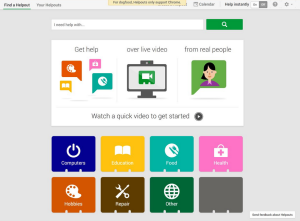 While its roots lie in search, today, Google wears many hats. From self-driving cars and wearable technology to social networking and mobile operating systems, there are few industries where the search and advertising giant has yet to make its presence felt. Lately, however, Google’s expansion has taken a noticeable tack in a more singular direction: e-commerce.
While its roots lie in search, today, Google wears many hats. From self-driving cars and wearable technology to social networking and mobile operating systems, there are few industries where the search and advertising giant has yet to make its presence felt. Lately, however, Google’s expansion has taken a noticeable tack in a more singular direction: e-commerce.With the outsized success Amazon and eBay have had building online marketplaces that seek to remove the barriers around buying and selling on the web, it was only a matter of time before Google decided to pull its chair up to the e-commerce table. Today, TechCrunch has learned via a tipster that Google has quietly been pursuing its marketplace ambitions under the auspices of a new platform that leverages its increasingly powerful cloud services to power live, real-time commerce.
The product, which has reportedly been named “Helpouts†and is currently being tested internally in Mountain View, will take shape as a marketplace that enables individuals and small and large businesses to buy and sell services via live video. With the capacity to connect merchants and consumers on both an immediate and scheduled basis, according to our tipster, the platform will allow sellers to create their own profiles and take advantage of reputation management, scheduling and payment features, while offering robust search and discovery tools for consumers.
Â
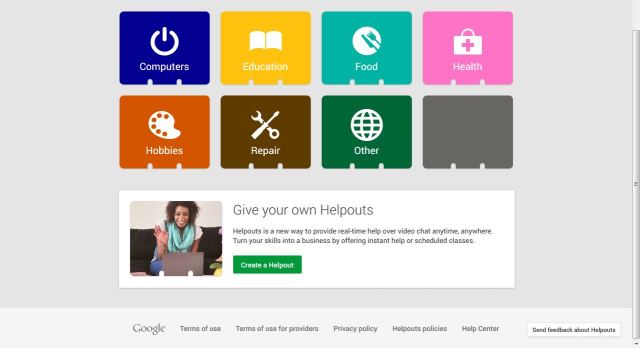
Â
From what we’ve heard, Google began internal testing of the product in late June, but may be at least a month away from a public release.
In the meantime, from what we can gather from leaked mockups of Helpouts, the platform seems reminiscent of eBay’s recent efforts to expand its own marketplace with the launch of Secretguru, its concierge-style platform that allows merchants to offer a range of services directly to consumers — from business mentoring to beauty tips.
Â

Â
According to our source, Helpouts, like these startups before it, will cover a range of categories, including computers, education, food, health, hobbies and repair. One can then imagine services on Helpouts ranging from health consultations and fitness classes to appliance repair support and cooking lessons.
Google has also apparently partnered with a number of brands during internal testing, including One Medical Group, Sears, Weight Watchers and Alliance Frances, for example. At launch, the platform will also reportedly include an array of individual merchants and instructors as well, from yoga gurus to fitness teachers — all of whom will be able to offer both free and paid services to consumers via Helpouts.
According to our sources, with Helpouts, Google is looking to remove some of the barriers that have traditionally stood in the way of the seamless delivery of live services. For example, using Helpouts, a Spanish tutor from Argentina could offer language training to students in Japan, while a Yoga instructor in New York would be able to provide classes to a stay-at-home mom in Wyoming and an appliance repair shop could walk a customer through fixing a broken fan in their laptop — with an Internet connection being the only requirement.
Under the new, “One Google†Era, the company has begun to prioritize a greater collaboration or interrelationship between its products. With Helpouts, one could also imagine how the platform can act as a logical extension of Google’s core search and ads business. For example, customers could connect to retailers and manufacturers to get recommendations and advice on product purchases — or receive guidance on how to set up their products.
This could work to shore up a nagging gap for Google: When it comes to product searches, people no longer turn to Google. It’s all about Amazon. It also wouldn’t be a stretch to imagine Helpouts connecting to YouTube to offer video or lesson playback or integrating with Google’s nerd glasses.
Â

Â
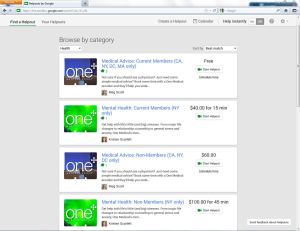 Of course, as with any Google product launch, life could be getting a little bit tougher for its smaller (and startup-y) competitors. There is a long list of businesses that either parallel or would directly compete with some part of Helpouts, whether it be LiveNinja, PowWow (which is, believe it or not, founded by a former Googler), Live Moka, InstaEdu, Shmoop and, perhaps less directly, platforms like Angie’s List, Udemy, Skillshare, TaskRabbit, CreativeLive and Curious. Though, admittedly, some of these overlap more than others. When it comes to big data or resources that can be thrown into curating a service offering like this, startups are bringing a knife to a gun fight. Firstly, there’s plenty of room for a more polished, higher-quality product in this space and, secondly, Google has video tech that’s already been widely adopted by individuals and businesses. Not to mention, most startups can’t hold a candle to Google’s marketing machine.
Of course, as with any Google product launch, life could be getting a little bit tougher for its smaller (and startup-y) competitors. There is a long list of businesses that either parallel or would directly compete with some part of Helpouts, whether it be LiveNinja, PowWow (which is, believe it or not, founded by a former Googler), Live Moka, InstaEdu, Shmoop and, perhaps less directly, platforms like Angie’s List, Udemy, Skillshare, TaskRabbit, CreativeLive and Curious. Though, admittedly, some of these overlap more than others. When it comes to big data or resources that can be thrown into curating a service offering like this, startups are bringing a knife to a gun fight. Firstly, there’s plenty of room for a more polished, higher-quality product in this space and, secondly, Google has video tech that’s already been widely adopted by individuals and businesses. Not to mention, most startups can’t hold a candle to Google’s marketing machine.Furthermore, according to our sources, Google has been building Helpouts in complete secrecy — well, until now — and few employees at the company were initially aware of the product, which has been developed by a team of two dozen engineers over the past year. Other than that, details are hazy. Perhaps Sergey and his secretive Google X unit are responsible. Only time will tell.
Â
 When it comes to big data or resources that can be thrown into curating a service offering like this, startups are bringing a knife to a gun
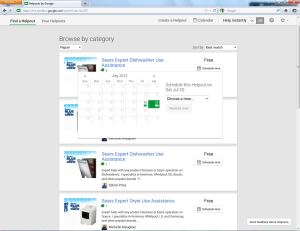 fight. Firstly, there’s plenty of room for a more polished, higher-quality product in this space and, secondly, Google has video tech that’s already been widely adopted by individuals and businesses. Not to mention, most startups can’t hold a candle to Google’s marketing machine.
fight. Firstly, there’s plenty of room for a more polished, higher-quality product in this space and, secondly, Google has video tech that’s already been widely adopted by individuals and businesses. Not to mention, most startups can’t hold a candle to Google’s marketing machine.Furthermore, according to our sources, Google has been building Helpouts in complete secrecy — well, until now — and few employees at the company were initially aware of the product, which has been developed by a team of two dozen engineers over the past year. Other than that, details are hazy. Perhaps Sergey and his secretive Google X unit are responsible. Only time will tell.
In the meantime, some may be wondering, if Helpouts is destined for YouTube (or at least HangOuts)-level adoption, or whether this is more of an experiment and it will just end up suffering the same fate as Reader or the geek-adored Wave. It’s not totally clear just how much marketing spend Google is going to dish out or whether it intends for this to have mass-appeal, but based on what we’re seeing, I would lean towards the affirmative.
Furthermore, while the type and date of the product’s rollout remain unclear, we’ve heard from sources that Helpouts was recently the subject of a company-wide meeting, which suggests that at least a few Googlers are taking this seriously.
Stay tuned for more.
By Rip Empson
DealerNet Services
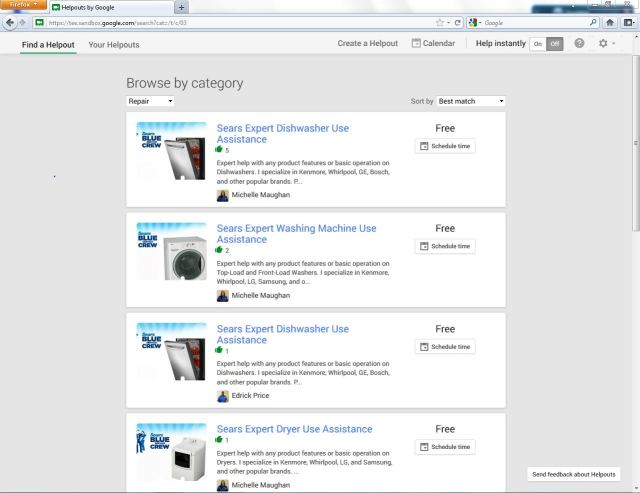
Photos Represent 93% Of The Most Engaging Posts On Facebook
Tags:According to the latest data, photos now represent 93% of the top posts on Facebook! That leaves status updates to generate only 3% of the most engaging content while links and videos each generate only 2%. It appears photos have completely taken over. Is it time for Facebook to merge Facebook and Instagram, forming one gigantic Facegram?
Videos used to do well on Facebook, but, since so many videos originate with Google's hated YouTube, which Facebook shuns, it's not surprising that videos, despite their popularity on the web, have faded away into oblivion on the blue giant. These days, posting links to useful webpages and articles on Facebook is also a lonely cause; you are the only one likely to see them. Status updates fare a bit better, but, if you really want your pals to see them, you better bleed your heart out.
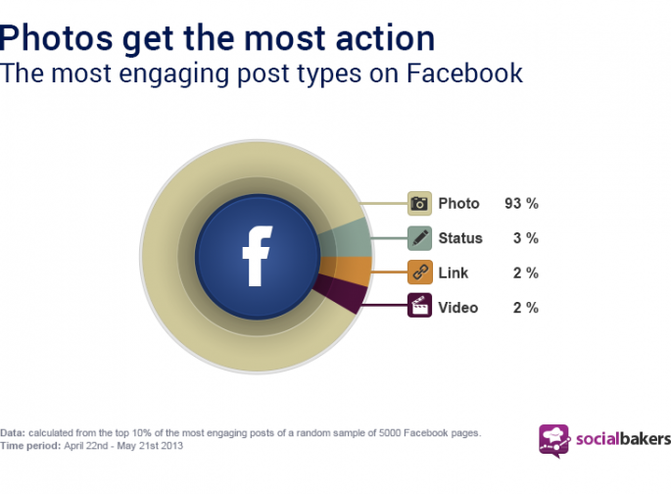
By Daniel Zeevi
DealerNet Services
 This is an interview I did with Klout for their Klout Stars series, where they ask “influencers†about their background in social media. 1. How did you get started in social media? I was originally a political consultant, helping manage campaigns for Governor, U.S. Senate, and President. I moved out of that industry into digital marketing in 1994. Since then, I’ve owned several companies in the online marketing world, including an award-winning agency that I sold in 2005. In 2008, I started Convince & Convert to help corporations and other agencies strip away the hype and successfully integrate social media.
This is an interview I did with Klout for their Klout Stars series, where they ask “influencers†about their background in social media. 1. How did you get started in social media? I was originally a political consultant, helping manage campaigns for Governor, U.S. Senate, and President. I moved out of that industry into digital marketing in 1994. Since then, I’ve owned several companies in the online marketing world, including an award-winning agency that I sold in 2005. In 2008, I started Convince & Convert to help corporations and other agencies strip away the hype and successfully integrate social media.
I love social because it’s the perfect combination of online marketing and retail politics. You’re trying to win hearts and minds one at a time, or a few at a time using stories and humanization, but you’re using digital techniques to do so, rather than salacious 30-second ads and cheesy direct mail.
I started my Convince & Convert blog to create a place that straddles the line between social media theory and social media execution, while always trying to show how social is an ingredient, not the whole entree. Same thing for The NOW Revolution: 7 Shifts to Make Your Business Faster, Smarter and More Social
the book I wrote with Amber Naslund. It’s not a book about doing social media, it’s a book about how companies can BE social.
2. What’s your strategy for the content you produce and share on social media?
My mom and stepdad were both high school teachers, as was my grandmother. Education (and tequila) runs through my veins. I see my role as that of a translator and coach, taking important social media principles and explaining them in a practical way to people who are very smart marketers and businesspeople, but not necessarily social media practitioners day-to-day. With my blog, my Twitter feed, my twice-weekly email newsletter, and other vehicles, I try to curate what matters and add a heavy dose of my own interpretation and advice.
3. What advice do you have for someone who wants to take their social media influence and presence to the next level?
Three things to remember:
First, it’s a paradox, but the more you “sell†the less you sell. You earn the right to promote in social, you can’t buy it. The difference between helping and selling is just two letters, but those letters mean everything. Find a way to genuinely help other people via social media, and it will come back to you five-fold eventually.
Second, realize that social media happens fast, but success is accrued very slowly. If you think you’re going to be able to get involved in social media and have massive influence in two months, you’re kidding yourself (unless you’re a celeb, in which case your influence just needs to be unlocked, preferably from aboard a yacht).
Third, there is NO shortcut. People invariably try to game the system, to increase their Klout score by doing this or doing that. I’m fortunate enough to have interacted with a lot of people who are (at least according to Klout score) considered influential in social media. And the only thing that is universal among them is that they worked extremely hard to make it happen. I firmly believe that just about anyone can make social media work for them, but you have to love it and you have to put in the time.
By Jay Bear
DealerNet Services  What is the common thread in the following statistics? Thirty-six percent increase in brand awareness, 66% less time to bring products to market, 20% improvement in customer conversions, 15% increase in successful innovations and new ideas?
What is the common thread in the following statistics? Thirty-six percent increase in brand awareness, 66% less time to bring products to market, 20% improvement in customer conversions, 15% increase in successful innovations and new ideas?Answer: These are just some of the quantitative results attributed to becoming a social business. With dramatic benefits like these, why aren't all businesses social by now? The fact is, becoming a social business can be quite difficult, especially without a well-thought-out implementation plan.
Today, social software and tools have made cross-functional collaboration easier than ever before but cultural and philosophical barriers still get in the way. Even with all the well-demonstrated benefits of collaboration -- improved internal and external communications, better use of constrained budgets, better customer relationships and shorter meetings -- the concept of the social business introduces elements of threat, loss of control and risk. For managers accustomed to hierarchical control, fully embracing social business can mean moving outside their comfort zone.
[ Want a better bottom line? Read Social Collaboration's Big Payoff: Increased Sales. ]
There exists a digital divide in business. On one side of the divide are those who view technology as a distraction, something that must be closely monitored and controlled. On the other side are those who embrace the technology megatrends of social, mobile and cloud. To innovate and thrive in today's rapidly changing environment, businesses must become social and bridge this digital divide.
To that end, here is a seven-step checklist for becoming a successful social business -- a checklist that has worked well for us at Enterasys.
1. Define A Meaningful Purpose.
Start by understanding where you want to go. Make sure everyone's goals are aligned. Your company culture will play an enormous role in becoming a social business, so take the time to understand and steer your company's culture in the right direction. If your people are not comfortable, they'll drop into what Christine Comaford calls their critter state. Provide the right company environment and you can move them into their collaborative smart state.
Make sure everyone sees the benefits of a social business. It won't mean more work; it will mean less email, fewer interruptions, less guesswork, fewer meetings. It will make work life more innovative and more fun.
2. Simplify The User Experience.
Ensure the tools for social business are easy and fun. They will get used as long as they are simple and integrate well into the general work environment and daily routine. At Enterasys, we use Salesforce.com and most employees keep it open and available on their desktops. When Chatter became available as a social communication tool integrated with Salesforce, it was a natural fit that helped speed adoption.
Be sure to encourage the use of online and mobile tools such as Evernote, wikis and blogs for taking meeting notes. That way the notes can be posted, shared and even edited immediately. Include social handles in all tools and interactions to make their use as easy as possible. Today people tend to keep Tweetdeck open on their desktop or mobile device and use it almost as often as email. Some people have completely switched from email to Twitter.
Becoming a social business rarely requires redesigning the organization. In fact, social businesses tend to avoid frequent reorganizations. The social tools are the lubrication that keeps cross-departmental and cross-functional information flowing freely, reducing the separation between groups.
3 Designate A SOCIAL Executive Sponsor.
Gartner estimates that 80% of social business projects will not achieve their intended benefits due to inadequate leadership. The executive leader must be S.O.C.I.A.L. -- sincere, open, collaborative, interested, authentic and likeable. Find -- or create -- an executive sponsor who meets these criteria: You're Not a Social Business Leader If ______? (10 Hints).
In some companies, the CMO might be the executive sponsor. Or it might be the VP of services or the chief customer officer. In a small startup, it might even be the CEO. Consider whether your company needs a chief social officer. The key is to find the most likeable, collaborative individual who has a large-scale influence -- and by the way, that might not necessarily be an executive. Embracing collaboration throughout a company requires participation and support from senior leadership. You are not a social business if your CEO and her direct reports are not actively using social technologies to collaborate and engage.
4. Trust Your People!
You have hired only trustworthy people, so trust them. Don't overanalyze corporate social collaboration guidelines. When you're trying to accomplish something revolutionary, it's best not to have too many variables, or you'll end up with analysis paralysis. Constraining interaction can have even worse consequences. Make sure everyone understands the concepts of the digital footprint and digital citizenship. A little awareness of these concepts goes a long way. There is some risk to eliminating filters and barriers, but the benefits of open collaboration outweigh these risks.
One of our early lessons involved senior management using Chatter to talk about non-work related subjects, including topics that showcased their personalities and interests. We came to realize that this was important. By bolstering employees' personal brands, you help bolster their work.
5. Implement And Drive Engagement With Social Tools.
Make social adoption a team sport. Create social collaboration functional groups. Every group has innovation leaders; pull them in early and enlist their help in engaging others. Try gamification techniques. Rethink your processes to include social tools. It doesn't have to be perfect the first time. Social businesses are agile, able to learn from their mistakes and pivot quickly.
At Enterasys, we wanted to use Salesforce Chatter to champion collaboration and promote the work of others. Our CEO, Chris Crowell, decided that the most important thing he could do to advocate collaboration was to share sales wins via Chatter. Chris would specifically name the salesperson and the customer and provide details about our sales victories. The entire company knew when we won, and the sense of pride and unity helped instill a positive attitude. Growth starts with this mindset.
To keep building momentum, provide "Lunch & Learns" or better yet, hold Google Hangouts for training on social media and collaborative software. Interactively delve into topics like the latest in social media tools and the art of tweeting and share best practices.
Enterasys uses a number of innovative social business activities to drive implementation. We hold frequent social "jams" built around Google Hangout to roll out new social initiatives. Trivia contests, where the responses must be submitted via Twitter, have helped increase employee engagement. We post tips and best social media practices to a wiki, which everyone can add to and edit. We are introducing "Flashback Thursdays," where we re-post past photos and blogs to reinforce earlier training.
6. Measure Adoption And Recognize Achievements.
Provide as much real-time feedback as possible. Analyze connections. See where it's working and where it's not. As Peter Drucker said, "What's measured improves." Let everyone know when assessments are coming so no one is surprised.
During our implementation, we wanted to measure adoption in order to promote the early adopters. The tracing and measurement became a vehicle to identify who was embracing collaboration. It was important for us to set the tone and manage the grassroots movement through positive intervention. Here is an example of the Chatter reporting dashboard.
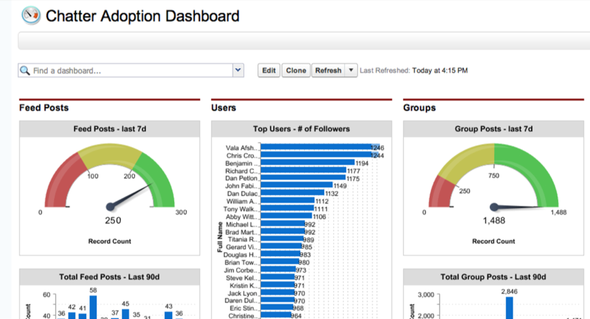
By Vala Afshar
DealerNet Services
 The psychology of color as it relates to persuasion is one of the most interesting—and most controversial—aspects of marketing.
The psychology of color as it relates to persuasion is one of the most interesting—and most controversial—aspects of marketing.
The reason: Most of today’s conversations on colors and persuasion consist of hunches, anecdotal evidence and advertisers blowing smoke about “colors and the mind.â€
To alleviate this trend and give proper treatment to a truly fascinating element of human behavior, today we’re going to cover a selection of the most reliable research on color theory and persuasion.â¨
Misconceptions around the Psychology of Color
Why does color psychology invoke so much conversation … but is backed with so little factual data?
As research shows, it’s likely because elements such as personal preference, experiences, upbringing, cultural differences, context, etc., often muddy the effect individual colors have on us. So the idea that colors such as yellow or purple are able to invoke some sort of hyper-specific emotion is about as accurate as your standard Tarot card reading.
The conversation is only worsened by incredibly vapid visuals that sum up color psychology with awesome “facts†such as this one:â¨

Don’t fret, though. Now it’s time to take a look at some research-backed insights on how color plays a role in persuasion.â¨
The Importance of Colors in Brandingâ¨
First, let’s address branding, which is one of the most important issues relating to color perception and the area where many articles on this subject run into problems.
There have been numerous attempts to classify consumer responses to different individual colors:â¨

... but the truth of the matter is that color is too dependent on personal experiences to be universally translated to specific feelings.
But there are broader messaging patterns to be found in color perceptions. For instance, colors play a fairly substantial role in purchases and branding.
In an appropriately titled study called Impact of Color in Marketing, researchers found that up to 90% of snap judgments made about products can be based on color alone (depending on the product).â¨
And in regards to the role that color plays in branding, results from studies such as The Interactive Effects of Colors show that the relationship between brands and color hinges on the perceived appropriateness of the color being used for the particular brand (in other words, does the color "fit" what is being sold).â¨
The study Exciting Red and Competent Blue also confirms that purchasing intent is greatly affected by colors due to the impact they have on how a brand is perceived. This means that colors influence how consumers view the "personality" of the brand in question (after all, who would want to buy a Harley Davidson motorcycle if they didn’t get the feeling that Harleys were rugged and cool?).â¨
Additional studies have revealed that our brains prefer recognizable brands, which makes color incredibly important when creating a brand identity. It has even been suggested in Color Research & Application that it is of paramount importance for new brands to specifically target logo colors that ensure differentiation from entrenched competitors (if the competition all uses blue, you'll stand out by using purple).
When it comes to picking the “right†color, research has found that predicting consumer reaction to color appropriateness in relation to the product is far more important than the individual color itself.⨠So, if Harley owners buy the product in order to feel rugged, you could assume that the pink + glitter edition wouldn't sell all that well.
Psychologist and Stanford professor Jennifer Aaker has conducted studies on this very topic via research on Dimensions of Brand Personality, and her studies have found five core dimensions that play a role in a brand’s personality:

(Brands can sometimes cross between two traits, but they are mostly dominated by one. High fashion clothing feels sophisticated, camping gear feels rugged.)
Additional research has shown that there is a real connection between the use of colors and customers’ perceptions of a brand’s personality.â¨
Certain colors DO broadly align with specific traits (e.g., brown with ruggedness, purple with sophistication, and red with excitement). But nearly every academic study on colors and branding will tell you that it’s far more important for your brand’s colors to support the personality you want to portray instead of trying to align with stereotypical color associations.â¨
Consider the inaccuracy of making broad statements such as “green means calm.†The context is missing; sometimes green is used to brand environmental issues such as Timberland’s G.R.E.E.N standard, but other times it’s meant to brand financial spaces such as Mint.com.
And while brown may be useful for a rugged appeal (think Saddleback Leather), when positioned in another context brown can be used to create a warm, inviting feeling (Thanksgiving) or to stir your appetite (every chocolate commercial you’ve ever seen).
Bottom line: I can’t offer you an easy, clear-cut set of guidelines for choosing your brand’s colors, but I can assure you that the context you’re working within is an absolutely essential consideration.
It’s the feeling, mood, and image that your brand creates that play a role in persuasion. Be sure to recognize that colors only come into play when they can be used to match a brand’s desired personality (i.e., the use of white to communicate Apple’s love of clean, simple design).
Without this context, choosing one color over another doesn't make much sense, and there is very little evidence to support that 'orange' will universally make people purchase a product more often than 'silver'.
Color Preferences by Gender
Perceived appropriateness may explain why the most popular car colors are white, black, silver and gray … but is there something else at work that explains why there aren’t very many purple power tools?â¨
One of the better studies on this topic is Joe Hallock’s Colour Assignments. Hallock’s data showcases some clear preferences in certain colors across gender.â¨
It’s important to note that one’s environment—and especially cultural perceptions—plays a strong role in dictating color appropriateness for gender, which in turn can influence individual choices. Consider, for instance, this coverage by Smithsonian magazine detailing how blue became the color for boys and pink was eventually deemed the color for girls (and how it used to be the reverse!).â¨
Here were Hallock’s findings for the most and least favorite colors of men and women:â¨
Men’s Favorite Colors

Women’s Favorite Colors

Men’s Least Favorite Colorsâ¨

Women’s Least Favorite Colors

The most notable points in these images is the supremacy of blue across both genders (it was the favorite color for both groups) and the disparity between groups on purple. Women list purple as a top-tier color, but no men list purple as a favorite color. (Perhaps this is why we have no purple power tools, a product largely associated with men?)
Additional research in studies on color perception and color preferences show that when it comes to shades, tints and hues men seem to prefer bold colors while women prefer softer colors. Also, men were more likely to select shades of colors as their favorites (colors with black added), whereas women were more receptive to tints of colors (colors with white added):


Keep this information in mind when choosing your brand’s primary color palette. Given the starkly different taste preferences shown, it pays to appeal more to men or women if they make up a larger percentage of your ideal buyers.â¨
Continued here The Psychology Of Color In Marketing And Branding
Written by Gregory Ciotti
DealerNet Services
 Brands, companies, and individuals -- I think it’s time for some real-talk about content and social media. Gary Vaynerchuk recently gave an interview about his decision to employ a full-time stalker (a.k.a “content personâ€) to chronicle, translate, and transcribe his every movement and remark into micro-content for various social media.
Brands, companies, and individuals -- I think it’s time for some real-talk about content and social media. Gary Vaynerchuk recently gave an interview about his decision to employ a full-time stalker (a.k.a “content personâ€) to chronicle, translate, and transcribe his every movement and remark into micro-content for various social media.While I respect Vaynerchuk’s incredible success and agree with his sentiment that micro-content and content in general is incredibly important to the future of business, I question whether encouraging brands and companies to develop this type of content is really what leaders in the social world should be doing.
This massively successful Slideshare presentation speaks to the already overwhelming amount of useless content we experience on a day to day basis. It states that “the single greatest threat to content marketing is content marketing.†The deluge of shoddy, slapped-together content and micro-content that content shops, farms, and agencies are churning out in an attempt to keep up with the growing desire for more and more media is actually what is making us (the collective number of people “listeningâ€) numb to content of quality.
I’m beginning to notice a “content double-take,†where readers are so glazed over scrolling through endless LOLcat updates and tweets about food that they almost (or sadly, sometime do) miss an incredibly important piece of content and have to scroll back to it after the few seconds it takes to sink in.
For instance how many reading actually know what’s happening in Turkey? Or that ExactTarget was acquired by Salesforce for billions of dollars? Or any equally important, business-specific update. I am totally guilty of this “double-take†predisposition and I’ve often missed opportunities to learn, grow as a consumer of content, and be informed about important, bottom-line impacting events. I’ve missed the chance to provide immense value to my community because of precisely the type of content Vaynerchuk is championing.
Do we, the brands and companies with the resources to develop consistent streams of content, want to build a culture of “fast food consumerism†around content and social media? Do we want to actively encourage QWERTY-vomit instead of meaningful, thoughtful insights that could actually benefit another human? Do we want to say without words that “fast and easy†holds more value than “thoughtful and creative?†Should the leading voices in this space really be creating and supporting this type of content?
I don’t think so.
We, as a collective, should be focusing on creating a smarter, more beneficial internet -- for everyone. Web media and the internet’s immense index of knowledge is fundamentally changing the way we learn and communicate across the world. It is the unspoken responsibility of those creating and pushing content (especially from high places) to not muck that up! A recent survey shows that 67.5% of professionals use social media to find and consume content for professional reasons every single day, and this percentage will only grow as more people around the world get connected to social networks.
It is our responsibility to do more, be better, and produce higher-quality resources than we did yesterday. People all over the world are looking to us, as leaders, for inspiration, guidance, and insight -- that they could follow in our footsteps and also be more than the sum of their parts. Failing to recognize this, or recognizing this fact and choosing to ignore it for the “easier†path, is negligent, insular, and selfish.
You may be saying to yourself “well, all that idealistic ‘we can make the world better’ sentiment is nice and all, but I really just care about my bottom line.†I respect your position as a business person but, unfortunately, the point that value and insight should be driving your content development still stands (see above, where 67.5% of professionals use social media to find and consume professional content every day). Diluting the landscape with meaningless drivel produces a more complex, chaotic content landscape that will actually make people pay attention to you less, which, at the end of the day, is the opposite of what we (as brands and business) want.
Let’s be real. More likely than not, if you are reading this, you are not in that top “1-5%,†which means you already have to go above and beyond to be heard through the noise on social media and the web in general. Do you really want to make this more difficult for yourself? Do you want to become a monotonous voice of constant, meaningless communication in a sea of identical monotonous voices or do you really want your message to shine and drive significant impact? Consider this: a recent poll of professionals on the Scoop.it platform presented data that one piece of high-quality content had brought in over $50,000 on average over the lifetime of that content.
A more organized and valuable internet benefits the world, our brands, and our future leaders for the long tail -- not just the short-term vision of the “top 1-5% of executives and social media personalities.†Random updates from the days of these top 1-5% won’t spark creativity or innovation -- the absolutely priceless insight and perspective which the positions of this top 1-5% afford them is what will inspire and help create the leaders of tomorrow. Brands and personalities should be known for who they are, what they stand for, and what they are best at -- not who can create the biggest firehose of social media data.
Who am I to say these things? No one, just a humble content person with a bigger vision for social media and content than tweets with no vowels. Someone who was inspired to do this work because of the incredible insights and sincerity I saw from the brands and online personalities that catapulted social media to its position in the ecosystem of the internet today.
I ask you, brands, companies, and individuals as a peer and fellow creator -- do you want to be remembered because you had amazing, beautiful, insightful things to give to the world or do you want to be remembered because you just wouldn’t shut up? The choice is yours.
ByClair Byrd
DealerNet Services
 What sets your company apart from everyone else’s? It’s the brand – and creating a better business starts with this key factor. Without a really good one, nothing sets your enterprise apart from the next one, and this won’t have customers clamoring to do business with you. Therefore, take a hard look at this aspect of your company, and figure out where any changes need to be made. Your business’s brand is essentially your promise to your customer, according to Entrepreneur magazine, and it sets the tone for all future relations. It is what sets you apart, and it is a reflection on everyone who works for a company. With a poor one, even the best products and services could be ignored. When it comes to branding your business, be the industry standard. Let customers know exactly what they are dealing with and the quality of services they should expect.
What sets your company apart from everyone else’s? It’s the brand – and creating a better business starts with this key factor. Without a really good one, nothing sets your enterprise apart from the next one, and this won’t have customers clamoring to do business with you. Therefore, take a hard look at this aspect of your company, and figure out where any changes need to be made. Your business’s brand is essentially your promise to your customer, according to Entrepreneur magazine, and it sets the tone for all future relations. It is what sets you apart, and it is a reflection on everyone who works for a company. With a poor one, even the best products and services could be ignored. When it comes to branding your business, be the industry standard. Let customers know exactly what they are dealing with and the quality of services they should expect.
It all starts with the logo
Not surprisingly, one of the first elements of a brand people see is the logo. That is why it is crucial to make it the best it can possibly be. The logo can make or break a company, and while it is often the first element seen, it can frequently be the last thing remembered. Think about all of the iconic logos - BMW, Coca-Cola, Nike – the list could go on for a long time, but the point is that they are all quite memorable in their simplicity. This is the ultimate goal for branding your business. Create the perfect logo so a customer can’t get it out of their head.
“Other people have to be able to speak for your brand,†said Jonah Berger, associate professor of marketing at the Wharton School of the University of Pennsylvania. “You love your company, you think your company is great, but if you’re not around, what are people going to be able to remember? And what are they going to tell others?â€
Therefore, when starting to craft a brand identity, it is best to keep it simple. The iconic logos previously mentioned all had something in common – simplicity. That is one of the major reasons as to why each one stays in your head. They manage to convey a lot about a company while not being distracting or overly ambitious. For example, Apple started with a more complex version of the logo we all know today. If you remember, it used to be rainbow-colored, and the more intricate predecessor of the plain, black or grayscale version apparent on many tech items today. Berger added that the easier it is to look over a logo, the more desirable it becomes. Apple was smart to simplify - it was less difficult to see the apple and remember with less bells and whistles. Most of the iconic logos have fewer than three colors, and this is for good reason.
To make a company really stand out over a long period of time, the logo also needs to be flexible. What this means is that a company can’t get locked in to an idea. Something that works now might not work in five years, or 10 years, and so on. Perhaps it may not even work in a shorter amount of time, and it is up to management to be able to change quickly and not let affection or ego cloud good business strategy. For example, the Apple logo speaks perfectly to this. The rainbow-colored one was great when the company was a fraction of the global giant it is today, but things change, and the bright, multi-faceted fruit doesn’t convey the same connotations that its monotone counterpart does now.
All of these elements speak to memorability. Don’t make it difficult for a customer to remember your business. Help them along, and at the same time try to convey as much as possible about what the company does. Take a simple concept and give it a small slice of spice, like when Apple decided to take a bite out of its logo.
A great brand should “help them remember that you exist and what you stand for,†added Berger - without a little variety, “it might be easier to process, but [you'd] be less likely to remember, because it looks exactly like a million things you’ve seen before.â€
The best way to know if the methods you use for branding your business are working it to try them. Put a new logo out there and see what people think.
Keep your brand short, sweet, and adaptable
The concepts many businesses use for marketing change often. If your company can’t change right along with them, odds are it won’t succeed. According to Inc. magazine, the old themes of business marketing involved creating a product that has broad appeal, reaching an audience as large as possible and creating a recognizable brand name that can span multiple products. While elements of these hold true in some fashion, the marketing world is evolving, and your company should too.
Due to the growing technologies available today, it requires a different touch to brand well. The Internet and media have divided consumers into smaller categories, and it has also shortened attention spans and has turned many people into the “what have you done for me lately?†types. Therefore, the strategies you use need to be customized to appeal to very specific consumers.
Therefore, a great business brand should target a specific type of person - one that is most likely to buy your product. This brand should attempt to gain support among these consumers, which will help bring new business in. In addition, customer feedback will help define your brand in the future, setting the tone for future marketing strategies. Listen to everyone - social media can be a great way to get instant opinions.
New strategies are more narrow than the older ones, and a business really has to know who its clientele is. The best method for branding your business is to let your consumers dictate the direction. What makes your brand memorable, and what branding strategies do you want to implement in the future?
by Amy Atwood
DealeNet Services
Â
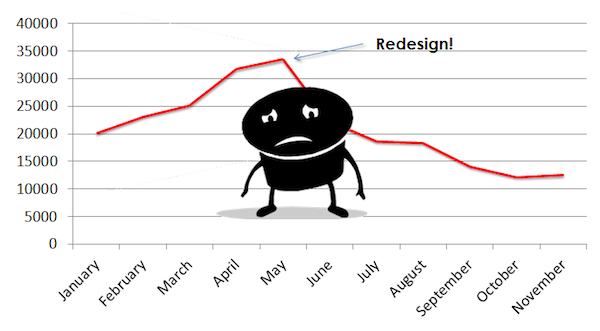 Planning a website redesign can be an extremely exciting process. You have a blank canvas to which you can easily add your own creativity and flair. It's tempting to get carried away.
Planning a website redesign can be an extremely exciting process. You have a blank canvas to which you can easily add your own creativity and flair. It's tempting to get carried away.
Unfortunately, most designers and creative teams will use this opportunity to focus entirely on the visual design of the site, and overlook SEO, content, and functionality.
Sites with a history of good search traffic can see most or even all of that traffic vanish after a redesign. That new site may look great, but that won't be much consolation to their owners!
Yes, it's important to have a great looking website. It needs to look great if it's going to convert your visitors into paying customers, but traffic, conversions, and functionality are what will ultimately govern its success or failure.
So, what are the key considerations when implementing a site re-design?
1. Have You Done Your Research?
To design a website that's going to deliver results, you need to know who you're targeting. The design, functionality, and SEO focus should all be dictated by informed research. That means market research, keyword research, and community mapping.
This should be your first port of call, not an afterthought. If you have this information from the very beginning you can then use in in every aspect of your redesign.
Benchmarking your existing data will allow you to identify what is currently working, and what has worked in the past. Be sure to evaluate which pages are the most popular, convert the best, rank and deliver the most leads/sales. Doing so will fuel the new site with proven techniques and allow you to gauge the site's success post-launch.
2. Website Structure
A redesign isn't simply a chance to give your website a fresh look. It also gives you the opportunity to reorganize the way your site is structured.
To make sure your information architecture is set up for optimal visibility and conversions, your priority should be analyzing the effectiveness of your current site:
- Which pages convert the best?Â
- What's the most common route through your website?Â
- Do some pages have a high bounce rate?
Use all of this information to improve the architecture of your new site.
Mobile phones, tablets and alternative devices must also be considered. There are a few primary approaches:
- Responsive
- Adaptive
- Mobile site
- Apps
Each approach has their advantages. You'll want to consider factors like site goals, personalization, site complexity, timeframe, and budgets.
3. Redirects – 301 & Canonicals
Inventory all pages, incoming links, and pages that rank well from the very beginning. Don't forget about subdomains.
As the URL structure is changed, a redirect strategy will be incredibly important to retaining any SEO rankings and rerouting referral traffic to the new pages/URLs.
Audit and analyze where all incoming links are coming from, and going to. This can be done using tools like Open Site Explorer and Majestic SEO, among others.
Once you have an inventory of backward links, you'll want to map them along with all pages to their new location using 301 redirects. This is also a great time to establish your canonical strategy for "www", index files, and other forms of duplicate content.
Tip: The redirect strategy will likely change based on design, navigation, and content, among other factors. Knowing this in advance will help alleviate future frustrations.
4. Navigation
How easily your site can be navigated, by both human visitors and search engine spiders, will have a significant effect on the visibility and success of your new website. You need to look at site structure from two different standpoints:
-
How are people going to find your site? This is where you need to be thinking about your URL structure. Can it be shortened? Are there lots of unnecessary characters? Does the URL give pride of place to the term you'd most like that page to rank well for?
A redesign gives you the chance to give your entire URL structure a reshuffle and cut away any dead wood that may have developed as part of your existing site's development. Your new URL structure and sitemap should make it easy for the search engines to see what each page is about and make sure that you're using the most important terms for each of your campaigns. -
How your human visitors will navigate the site once they've found it? Which pages have you identified as your primary entry points? What action do you want visitors to each of these pages to take? What journey will they need to take in order to take that desired action? Can you do anything to shorten this journey or increase conversions?
By taking an informed, data-driven look at your existing site structure and optimizing it in line with your new site's primary objectives, you have a chance to drastically improve the performance of your site.
5. Where Does the Content Fit In?
We all know that content is the most important aspect of any digital campaign. So why is it still so often an afterthought when sites are designed?
The quality, visibility, and relevance of your content will be the most influential factor in determining the success or failure of your new site. Shouldn't it be given some attention during the design process?
One primary consideration is what type of content will be published on-site.
- Are you going to have a blog?Â
- Is that blog going to be mostly visual or will you be publishing long, informative articles?
These questions should always be answered before you start designing the site. This gives you the opportunity to effectively integrate the blog into the overall design of your new website. It will also give you a chance to make sure that visitors can always find the most relevant content for them – and that they can find your blog, no matter what page they're on.
Another consideration is whether you'll be offering any other content through your site.
- Will you be publishing whitepapers, eBooks, video tutorials?Â
- If so, how will they be delivered?Â
- Will you offer them in return for an email address?Â
- Will they be available to anyone, or only available to members?
As with each of the previous points, considering your content before you finalize the site design will make it far more functional, profitable, and effective.
6. Technical SEO
Your site's position in the SERPs depends on many different factors (more than 200, according to Google). This means that your redesign gives you more than 200 different areas that you can look to improve, condense, and build on to increase your search visibility, site authority, and trust.
Three key areas you should pay close attention to during the redesign process are:
- Page load times: Far too often companies launch a site that looks great, but only if you wait around for long enough for the homepage to load. Unfortunately, visitors to your site won't put up with it, and as a result, neither will the search engines. Your redesign should be seen as an opportunity to speed up your site, not slow it down.
- Compliance: This area is also often overlooked by site designers. If you want your site to work in the modern online marketplace it needs to conform to recognized standards. This means it needs to adhere to section 508 and W3C compliance factors as well as EU Cookie laws (if applicable).
- Coding: Your site redesign should be seen as an opportunity to give your code a spring-clean. As you know, search engine spiders can only read text. Images, videos and other web elements can all hide and disguise this text so that search engines have difficulty reading it. This means that they are also very unlikely to give your pages high visibility for those disguised terms. To ensure that your site has the greatest possible search visibility, you need to make sure that your code makes it as easy as possible for the spiders to crawl your site. If you're in any doubt, use a tool like this to see your pages from a search engines point of view.
7. Testing
In an ideal situation, budgets and time would be unlimited. If we had the budget and time, every single component of the site would be pitted in a death match fight to the death based on analytical data. This would include all wireframes, mock-ups, images, color, content and the list goes on.
Obviously, we can't do this. But don't forget about the advantages gained if we could, and remember to incorporate testing into your process.
Conclusion
Digital marketing is quickly evolving into an entirely integrated discipline. A website redesign is a major event in any digital marketing campaign, so it makes sense that this process should also be as integrated as possible.
If a site is going to deliver real value, it shouldn't be left to just designers and aesthetic considerations. Your SEO team, copywriters, sales team and social media managers should all be heavily involved, right from the start.
By Brad Miller
http://dealernetservicesonline.biz
CALENDAR
CATEGORIES
TAGS
TWITTER POSTS
CALENDAR
- powered by
- One Big Broadcast
- creative by
- WebStager
© 2024 One Big Broadcast | All rights reserved
